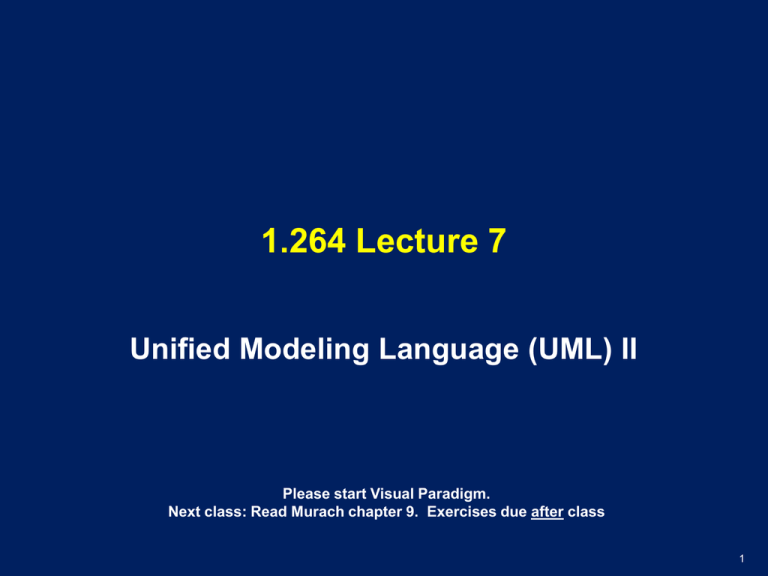1.264 Lecture 7 Unified Modeling Language (UML) II Please start Visual Paradigm.
advertisement

1.264 Lecture 7 Unified Modeling Language (UML) II Please start Visual Paradigm. Next class: Read Murach chapter 9. Exercises due after class 1 Dynamic UML models • While static models (use cases, class diagram, component diagram) are done for the system as a whole, dynamic models are done only for key components • State diagram – Specifies behavior of a single object – Diagram has states and transitions only • Sequence diagram – Shows details of one scenario and messages that flow between objects/organizations in that scenario over time – Heavily used in standards • Activity diagram – Shows flow of logic, data, messages – Diagram has activities, decisions, forks, joins (parallel) – Replaces flow charts • Communication diagram – Shows flow of messages as a graph – Used as variant of sequence diagram • Others, as needed 2 State diagram example Initial State State Transition Self Transition Final State An object (account in this example) can be in only one state at any time 3 State diagram exercise • Model the state transitions of a student’s registration in this class: – – – – – Preregistered Registered Listener Dropped Complete, incomplete (not resolved), etc. • Remember that an entity can only be in one state at any time. It cannot be in two or more states. 4 State diagram solution 5 Activity diagram • Shows flow of messages, logic, actions • This is at a much higher level of abstraction than flow charts – Flow charts show logic for single method (if statements, loops, etc.) – Activity diagrams show flow among objects 6 Activity diagram example Initial Node Activity Node Fork (parallel) Decision (either-or) Merge (either-or) Join (parallel) Final Node 7 Activity diagram exercise • Draw an activity diagram for getting an apartment. Example activities are: – – – – – – – – Find roommates Find apartment Sign apartment lease Get electric service Get phone or cable TV service Get gas or oil heat account set up Obtain furniture Move in • (Use this as a simple model of setting up a warehouse…) • Use activities, decision nodes, fork/join nodes 8 Activity diagram solution 9 Sequence diagram (optional) • Objects or entities are diagrammed at the top • Each object’s life is represented by a vertical line from creation to destruction • Messages or events are diagrammed from the sending object to the receiving object, in the order in which they occur • Responses may or may not be diagrammed, depending on complexity/obviousness • These are sometimes called ‘swim lane’ diagrams – Swim lanes can be used in activity diagrams as well 10 Sequence diagram example 11 UML Summary • Use UML while writing scenarios and narratives as an initial requirements document – Diagram use cases, then refine them into scenarios – Focus on completeness of use cases • Use UML component diagrams to list all system elements – Focus on completeness, and use to set system boundaries • Prepare the initial data model (next lecture) – Add operations/methods to the entities, after understanding the data, to create a class diagram • Use UML state diagrams, sequence diagrams and activity diagrams to specify objects and processes – Prepare these selectively for complex or interesting objects • UML is becoming a ‘universal’ language: staff coming to a project know it, which sharply reduces learning curve – Developers and analysts can both understand it readily – Consultants/analysts use UML even for analysis-only projects (as well as writing requirements and modeling data) – Business process execution language (BPEL) in Web lectures is UML extension to directly create systems 12 MIT OpenCourseWare http://ocw.mit.edu 1.264J / ESD.264J Database, Internet, and Systems Integration Technologies Fall For information about citing these materials or our Terms of Use, visit: http://ocw.mit.edu/terms.




